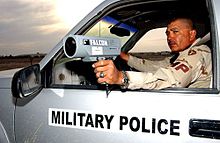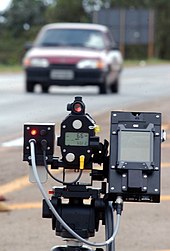Radar speed gun: Difference between revisions
m + zh: |
→How radar guns work: new photo |
||
| Line 13: | Line 13: | ||
A radar beam is similar to a beam of light in that it spreads out as the distance from the signal origin increases. The signal then bounces off objects in the path of the beam and are reflected back to the gun. The gun uses the Doppler effect to calculate the speed of the object in the beam's path. Using a comparison of frequency shift between received images instead of the frequency shift between sent and received frequencies creates what is known as moving radar. Unless the radar system has a provision for converting own-vehicle-speed to an appropriate receiver frequency offset then the radar must be stationary to measure speed. |
A radar beam is similar to a beam of light in that it spreads out as the distance from the signal origin increases. The signal then bounces off objects in the path of the beam and are reflected back to the gun. The gun uses the Doppler effect to calculate the speed of the object in the beam's path. Using a comparison of frequency shift between received images instead of the frequency shift between sent and received frequencies creates what is known as moving radar. Unless the radar system has a provision for converting own-vehicle-speed to an appropriate receiver frequency offset then the radar must be stationary to measure speed. |
||
[[Image:ZA Radar Gun.jpg|thumb|left|A [[South Africa|South African]] policeman using a radar gun mounted on a [[tripod]].]] |
|||
All bands of radar operate on different frequencies, work differently, and are very complicated. [[X band]] guns are becoming less common due to the fact the beam is strong and easily detectable. Also, most automatic doors utilize radio waves on X band and can possibly affect the readings of police radar. As a result [[K band]] and [[Ka band]] are most commonly used by police agencies. |
All bands of radar operate on different frequencies, work differently, and are very complicated. [[X band]] guns are becoming less common due to the fact the beam is strong and easily detectable. Also, most automatic doors utilize radio waves on X band and can possibly affect the readings of police radar. As a result [[K band]] and [[Ka band]] are most commonly used by police agencies. |
||
Revision as of 19:57, 2 September 2010


A radar gun or speed gun is a small doppler radar unit used to detect the speed of objects, especially trucks and automobiles for the purpose of speed limit enforcement, as well as pitched baseballs, automatic door openers, runners or other moving objects in sports. A radar gun does not return information regarding the object's position. It relies on the Doppler effect applied to a radar beam to measure the speed of objects at which it is pointed. Radar guns may be hand-held, vehicle-mounted or static.
Most of today's radar guns operate at X, K, Ka, IR Band (infrared), and (in Europe) Ku bands. An alternative technology, LIDAR, uses pulsed laser light.
The radar gun was invented by Bryce K. Brown of Decatur Electronics in March 1954[1], and was first used in Chicago, Illinois by Patrolman Leonard Baldy in April 1954.
There are radar detectors on the market which can detect most police radar and laser systems. Conversely, in the spirit of electronic warfare, some police radars are equipped with detectors of operating detectors.
How radar guns work
Radar guns are, in their most simple form, radio transmitters and receivers. They send out a radio signal, then receive the same signal back as it bounces off the objects. However, the radar frequency is different when it comes back, and from that difference the radar gun can calculate object speed.
A radar beam is similar to a beam of light in that it spreads out as the distance from the signal origin increases. The signal then bounces off objects in the path of the beam and are reflected back to the gun. The gun uses the Doppler effect to calculate the speed of the object in the beam's path. Using a comparison of frequency shift between received images instead of the frequency shift between sent and received frequencies creates what is known as moving radar. Unless the radar system has a provision for converting own-vehicle-speed to an appropriate receiver frequency offset then the radar must be stationary to measure speed.

All bands of radar operate on different frequencies, work differently, and are very complicated. X band guns are becoming less common due to the fact the beam is strong and easily detectable. Also, most automatic doors utilize radio waves on X band and can possibly affect the readings of police radar. As a result K band and Ka band are most commonly used by police agencies.
Traffic radar comes in many models. There are hand held, stationary and moving radar instruments. Hand held units are mostly battery powered, and for the most part are used as stationary speed enforcement tools. Stationary radar is mounted in police vehicles, and may have one or two antennae. These are employed when the vehicle is parked. Moving radar is employed, as the name implies, when the police vehicle is in motion. These devices are very sophisticated, able to track vehicles approaching and receding both in front of and behind the patrol vehicle. They can also track the fastest vehicle in the selected radar beam, front or rear.
